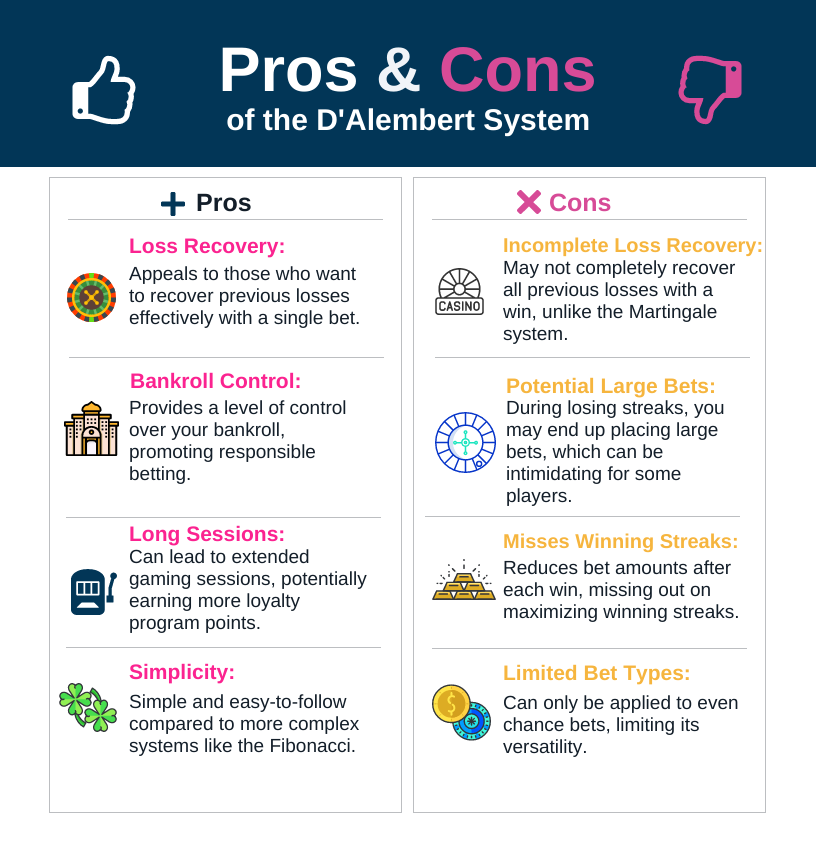
The D’Alembert System – History and Analysis
Many people like the D’Alembert approach because it’s easy to understand. It’s similar to the Martingale system and encourages players to bet more after losing a roulette round. Some people even call it the father of all betting systems. Let’s learn more about why this strategy is so sought-after.
The History of Strategy
The D’Alembert system is a betting method used in gambling games for many years. A famous French mathematician, physicist, and philosopher named Jean-Baptiste le Rond d’Alembert created it. He was interested in many scientific subjects, including gambling and game theory. D’Alembert’s betting strategy aims to make the most profit while losing the least money. The idea is to balance wins and losses to make a net profit. Players commonly use the strategy in games with even or near-even odds, like baccarat and roulette.
The Principle of Operation of the Strategy
The basic principle is to raise your bet by one unit after a loss and lower it by one unit after a win. This strategy aims to profit from winning streaks while limiting losses during losing ones.
Players have changed the D’Alembert system over time to deal with problems. The inverse D’alembert system, often called the Contra D’alembert system or the Anti-Martingale system, is one version. In this variant, participants raise their bets after a win and lower them after a loss.
The Mathematics of This System
The player uses the D’alembert technique to bet on events with odds of 2 to 4. They should only use up to 3% of their bank for the first bet, usually one unit. The goal is to make a profit equal to the first bet. Here is the betting algorithm:
- Pick a bet with odds from 2 to 4.
- Set the bet to one and distribute between 1 and 3 percent of the game pot.
- If the bet succeeds, the next bet increases by one unit (1 unit if the bet was successful).
- The second bet is raised by one if the previous one fails.
- Start a new cycle if you can make 5-10% of your bets.
The player has a wide choice of events due to the circumstances of the odds. He can bet on various sports and positions. These are not guaranteed results; you can also use totals, handicaps, period bets, and individual player performance bets.
Main Advantages and Disadvantages of the D’Alembert system

Success Story
Don Johnson is a famous gambler who used the D’alembert System to win $6 million at the Borgata Casino & Spa in Atlantic City in 2011. He started with a small bet of $5 and gradually increased it as he won. Don believes that discipline is essential for successful gambling. Without self-control, a player may make bad decisions and lose money.
To cap it all, the system raises bets after losing and lowers them after winning to minimize losses and increase profits. Before using this strategy, it’s pivotal for players to learn how professionals use it and understand how it works.
Sources:
Related articles
- What Are the Different Bet Types in Roulette?
- What Are Roulette Odds?
- The Labouchere System – Analysis & Review
- The Fibonacci System – A Low-Risk Strategy for Roulette
- The Martingale System – Overcoming the Odds?
- The James Bond Roulette Strategy – Can 007 Beat the House Edge?
- The Biggest Roulette Wins of All Time – 2023 Guide
- Professional Roulette Players – Secrets of Successful Gamblers
- Roulette Wheel and Table Guide 2024 – The Layout Explained
- Online Roulette Real Money
- The Seven Best Roulette Strategies
- American Roulette in Online Casino
- European Roulette
- French Roulette in Online Casinos
- Mobile Roulette in Online Casinos







